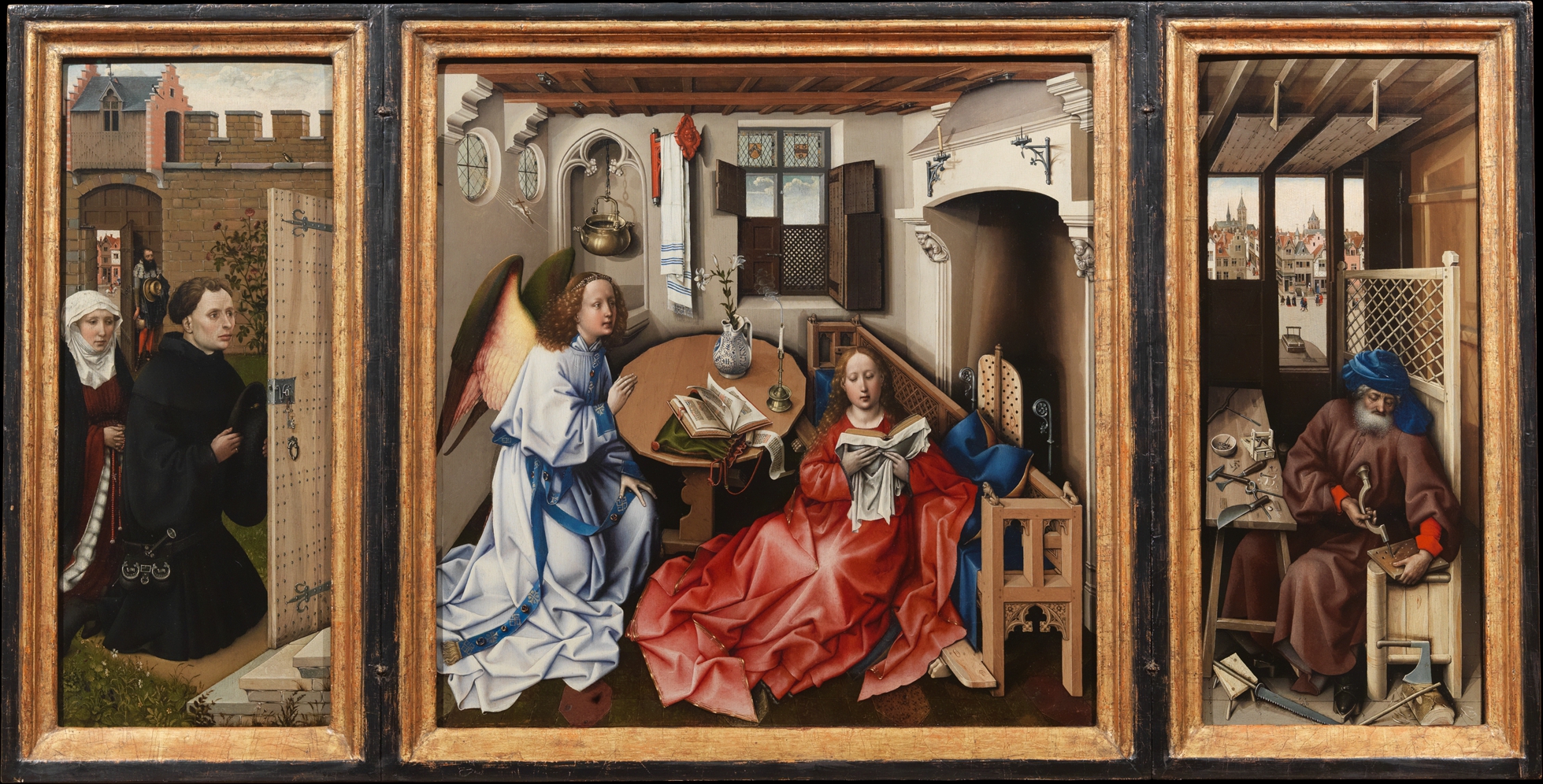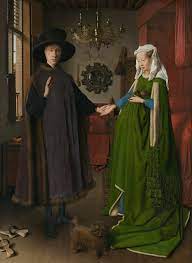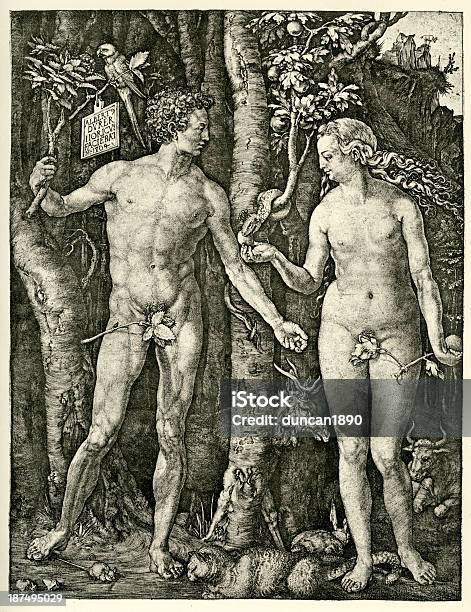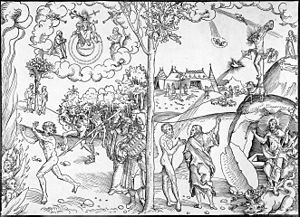ap art history: late gothic, northern renaissance, reformation
1/6
There's no tags or description
Looks like no tags are added yet.
Name | Mastery | Learn | Test | Matching | Spaced |
|---|
No study sessions yet.
7 Terms

LATE GOTHIC
Lamentation by Giotto di Bondone
Arena (Scrovegni) Chapel
fresco
FORM
■Shallow stage; figures occupy a palpable space pushed forward toward the picture plane.
■Diagonal cliff formation points to main action daringly placed in lower left-hand corner.
■Modeling indicates direction of light; light falls from above right.
■Figures seen from the back isolate the main action.
CONTENT
■Lamentation shows scenes of Jesus’s followers mourning his death. Usually the scene contains Mary, Saint John, and Mary Magdalene.
■Saint John throws his hands back—recalling his iconographical symbol as an eagle; Mary Magdalene cradles Jesus’s feet; Mary holds Jesus’s head.
■At left is the Old Testament scene of Jonah being swallowed by the whale and returning to life, a parallel with the New Testament scene of Christ dying and rising from the dead.
■Range of emotions: heavy sadness, quiet resignation, flaming outbursts, despair.
■Sadness of scene emphasized by grieving angels.
■Leafless tree echoes the theme of death in the painting; also represents the tree of the knowledge of good and evil in the Garden of Eden, which dies after Adam and Eve are expelled; a dead tree also symbolizes the wood of the cross Jesus was crucified on.
■Christians believe Jesus sacrificed himself, in part, to expiate the expulsion from the Garden of Eden.

NORTHERN RENAISSANCE
Annunciation Triptych by Robert Campin
oil on wood
FORM
■Triptych, or three-paneled altarpiece.
■Meticulous handling of paint; intricate details are rendered through the use of oil paint.
■Steep rising of the ground line; figures too large for the architectural space they occupy.
FUNCTION
■Meant to be in a private home for personal devotion.
Technique
■Oil paint gives the surface a luminosity and shine.
■Oil allows for layers of glazes that render soft shadows.
■Oil can also be erased with turpentine, allowing for changes and corrections.
CONTENT
■Left panel: donors, middle-class people kneeling before the holy scene.
–Messenger appears at the gate to an enclosed garden.
■Center panel: Annunciation taking place in an everyday Flemish interior.
–Symbolism
•Towels and water represent Mary’s purity; water is a baptism symbol.
•Flowers have three buds, symbolizing the Trinity; the unopened bud represents the unborn Jesus.
•Mary is seated on a kneeler near the floor, symbolizing her humility.
•Mary blocks the fireplace, the entrance to hell.
•The candlestick symbolizes Mary holding Christ in the womb.
•The Holy Spirit with a cross comes in through the window, symbolizing the divine birth.
– Humanization of traditional themes: no halos, domestic interiors, view into a Flemish cityscape.
■Right panel: Joseph is working in his carpentry workshop; the mousetraps on the windowsill and the workbench symbolize the capturing of the devil.
–The mousetraps on the bench and in the shop window opening onto the street are thought to allude to references in the writings of Saint Augustine identifying the cross as the devil’s mousetrap.
CONTEXT
■Unusually, the main panel was not commissioned.
■Wings were commissioned when the main panel was purchased; the donor portrait was added at this time.
■After the donor’s marriage in the 1430s, the wife and messenger were added, which accounts for the rather squeezed-in look of the donor’s wife

NORTHERN RENAISSANCE
Arnolfini Portrait by Jan van Eyck
oil on wood
FORM
■Meticulous handling of oil paint; great concentration of minute details.
■Linear perspective, but upturned ground plane and two horizon lines unlike contemporary Italian Renaissance art.
■Great care is taken in rendering elements of a contemporary Flemish bedroom.
THEORIES
■Traditionally assumed to be the wedding portrait of Giovanni Arnolfini and his wife.
■It may be a memorial to a dead wife, who could have died in childbirth.
■It may represent a betrothal.
■Arnolfini may be conferring legal and business privileges on his wife during an absence.
■The painting may have been meant as a gift for the Arnolfini family in Italy. It had the purpose of showing the prosperity and wealth of the couple depicted.
CONTEXT
■Symbolism of weddings:
–The custom of burning a candle on the first night of a wedding.
–Shoes are cast off, indicating that the couple is standing on holy ground.
–The groom is in a promising pose.
–The dog symbolizes fidelity.
■Two witnesses in the convex mirror; perhaps the artist himself, since the inscription reads “Jan van Eyck was here 1434.”
■The woman pulls up her dress to symbolize childbirth, although most likely she is not pregnant; the gesture may simply be a fashion of the time.
■Statue of Saint Margaret, patron saint of childbirth, appears on the bedpost.
■The man is standing near the window, symbolizing his role as someone who makes his way in the outside world; the woman appears further in the room to emphasize her role as a homemaker.
■Wealth is displayed in the opulent furnishings, the elaborate clothing, and the importing of fresh oranges from southern Europe.

NORTHERN RENAISSANCE
Adam and Eve by Albrecht Durer
engraving
FORM
■Influenced by classical sculpture; Adam looks like the Apollo Belvedere, and Eve looks like Medici Venus.
■Italian massing of forms, which he learned from his Italian trips.
■Ideal image of humans before the Fall of Man (Genesis 3).
■Contrapposto of figures from the Italian Renaissance, in turn also based on classical Greek art.
■Northern European devotion to detail.
CONTENT
■Four humors are represented in the animals: cat (choleric, or angry), rabbit (sanguine, or energetic), elk (melancholic, or sad), ox (phlegmatic, or lethargic); the four humors were kept in balance before the Fall of Man; the humors fell out of balance after the successful temptation of the serpent.
■The mouse represents Satan.
■The parrot is a symbol of cleverness.
■Adam tries to dissuade Eve; he grasps the mountain ash, a tree from which snakes recoil.
CONTEXT
■Prominent placement of the artist’s signature indicates the rising status of his occupation.

NORTHERN RENAISSANCE
Allegory of Law and Grace by Lucas Cranach the Elder
woodcut and letterpress
FUNCTION
■Designed using the woodcut technique to make the image available to the masses.
■Its purpose was to contrast the benefits of Protestantism versus the perceived disadvantages of Catholicism.
■Influential image of the Protestant Reformation; text appears in the people’s language: German, and not the church language: Latin.
CONTEXT
■Protestantism: the faithful achieve salvation by God’s grace; guidance can be achieved using the Bible.
■Meant to reflect the Lutheran ideas about salvation.
■Done in consultation with Martin Luther, a leader in the Protestant movement.
■Left: Last Judgment
–Moses holds the Ten Commandments.
–The Ten Commandments represent the Old Law, Catholicism.
–The Law of Moses is not enough; it is not enough to live a good life.
–A skeleton chases a man into hell.
■Right: Figure bathed in Christ’s blood
–Faith in Christ alone is needed for salvation.
–Symbolically, the barren branches of the tree on the left side contrast with the full bloom on the right.

NORTHERN RENAISSANCE
Hunters in the Snow by Pieter Bruegel the Elder
oil on wood
FORM
■Alpine landscape; typical winter scene inspired by the artist’s trips across the Alps to Italy.
■Strong diagonals lead the eye deeper into the painting.
■Figures are peasant types, not individuals.
■Landscape has high horizon line with panoramic views, a Northern European tradition.
■Extremely detailed.
FUNCTION
■One of a series of six paintings representing the labors of the months—this winter scene is November/December.
■Placed in a wealthy Antwerp merchant’s home.
■Patrons were wealthy individuals of high status; Bruegel’s paintings offered them a view of the world of the peasants.
CONTEXT
■Hunters have had little success in the winter hunt; dogs are skinny and hang their heads.
■Peasants in the sixteenth century were regarded as buffoons or figures of fun; Bruegel does not give them individuality but does treat them with respect.

NORTHERN RENAISSANCE
Isenheim Altarpiece by Matthias Grunewald
oil on wood
CONTEXT
■Placed in a monastery hospital where people were treated for Saint Anthony’s fire, or ergotism—a disease caused by ingesting a fungus that grows on rye flour.
■The name of the disease explains the presence of Saint Anthony in the first view and in the third.
■Theme: healing through salvation and faith; Saint Sebastian (left) was saved after being shot by arrows; Saint Anthony (right) survived torments by devils and demons.
■Those suffering in the hospital were brought before this image, which symbolized heroism, sacrifice, and martyrdom.
■Ergotism causes convulsions and gangrene.
First view
■A scene of the crucifixion is in the center:
–Surrounded by a symbolically dark background.
–Christ’s body is dead with decomposing flesh emphasized as inspired by the writings by the mystic Saint Bridget.
–Christ’s arms are almost torn from their sockets.
–The body is lashed and whipped.
–The agony of the body is unflinchingly shown and acts as a symbol for the agony of ergotism.
■A lamb holds a cross, a common symbol for Christ, who is called the Lamb of God.
■A chalice catching the lamb’s blood parallels the chalice used to hold wine—the blood of Christ—during the Mass.
■The crucified body of Christ would have paralleled the raising of the sacramental bread called the Eucharist.
■A swooning Mary is dressed like the nuns who worked in the hospital.
■When panels open to reveal the next scene, Christ is amputated. Patients suffering from ergotism often endured amputation.
■Amputation also in the predella: Christ’s legs seem amputated below the kneecap.
Second view
■Marian symbols: the enclosed garden, closed gate, rosebush, rosary.
■Christ rises from the dead, on the right; his rags changed to glorious robes; he shows his wounds, which do not harm him now
■Message to patients: earthly diseases and trials will vanish in the next world.
Third view
■Saint Anthony in the right panel has oozing boils, a withered arm, and a distended stomach: symbols of ergotism (this view is not illustrated on the AP exam).